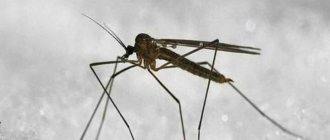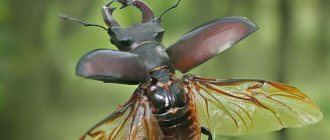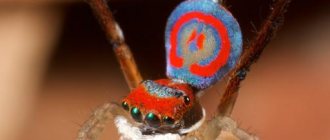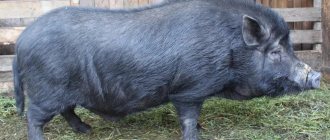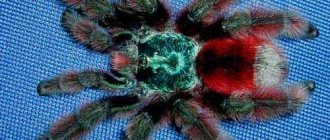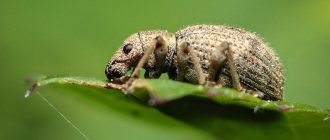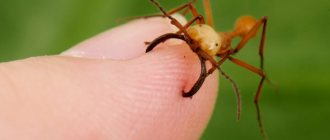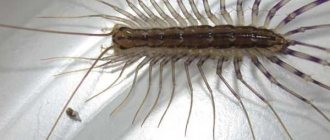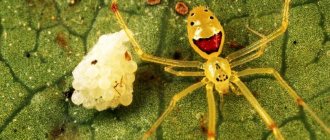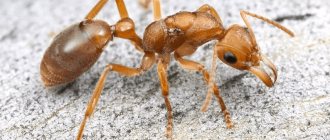Ecology
Our planet is home to a great variety of living creatures that are dangerous to humans, and they do not necessarily have to be large in size. Insects can cause a lot of harm. Insects have played an important role throughout history, they were mentioned in the Bible, and they were found in the graves of ancient Egyptians. They also appear in many literary works. However, insects do not particularly attract the attention of most of us, and some are even afraid of them, which is quite reasonable, given the not so pleasant characteristics of these creatures. There are very safe insects, but today we will talk about those that pose a particular threat and from which it is better to stay away.
1) Triatomine bugs
Insect order Hemiptera
includes a large number of different bugs.
Most species have distinctive suction mouthparts that resemble tubes. Most of them actually feed on plant sap, but there are also special species of the subfamily Triatomine bugs
that are not averse to feasting on the blood of large animals.
These insects carry a dangerous disease - Chagas disease
, which, fortunately, is found only in tropical areas of South America.
Symptoms of Chagas disease can vary depending on the time period after infection. At first it may be just a slight swelling, but as the disease progresses, more serious symptoms appear, such as heart problems and organ malformations. The disease can progress up to 12 years! If the patient is not treated from the very beginning of infection, the chronic disease leads to death. There are no effective treatments for this advanced stage of the disease, but medications can reduce the likelihood of death.
Diamphidia (Diamphidia locusta)
This is a small bug of light brown color with dark spots. Distributed in Central and Southern Africa. It is believed that this insect has the most powerful poison. However, it is not the bugs themselves that are poisonous, but their larvae. African tribes have been using larvae poison for a long time. Arrows treated with this toxin kill an animal of about 500 kg within a few hours. The poison remains deadly for a year.
The toxin affects the nervous system, and those who have received a portion of the poison are deprived of the ability to move and breathe, so the meat of killed animals is not contaminated, it can be eaten, it is only necessary to cut out part of the carcass near the arrow.
The poison kills a person almost instantly; there is no antidote yet. However, death from this toxin is very rare. The larvae are unsightly and are found in remote areas. They defend themselves and do not show aggression towards the living world.
2) Giant Asian hornets
This insect can reach a length of up to 7.5 centimeters. 20-30 such “animals” can devastate an entire hive of ordinary bees. The bite of such a hornet can kill, and not only because the poison causes an allergic reaction, but because it contains a huge amount of toxins. The venom contains the highest concentration of the pain-inducing chemical acetylcholine of any other stinging insect. The enzyme in this poison is capable of dissolving human tissue. Like all other hornets, this insect can sting several times.
Insects dangerous to humans
These insects surround humans everywhere. They bite painfully, release toxic substances, drink blood, and carry diseases and parasites.
Russia is home to many poisonous insects that can cause serious harm to humans.
Fleas
When bitten, a dangerous infection such as plague or typhus can be introduced into the body. There are five types of fleas in Russia:
- human;
- canine;
- feline;
- rabbit;
- rat.
Types of fleas
Fleas carry the pathogens of salmonellosis, pasteurellosis, brucellosis, hepatitis B and C, and tularemia. When bitten, saliva is released, which causes burning and itching.
Horseflies
Large and fleshy biting flies that actively attack people and animals and feed on their blood. Females prefer to bite wild and domestic mammals, but if there is no choice, they can begin to attack people.
At one time, a female horsefly sucks approximately 200 mg of blood. After drinking the blood of an animal, the insect becomes a carrier of dangerous infectious diseases, which can also be transmitted to humans.
Horseflies pose a danger to both humans and cattle
When bitten, a horsefly releases toxic saliva into the bloodstream, which causes severe itching on the skin. If you have an allergy, anaphylactic shock may occur.
The bite of a horsefly is one of the most painful among insects. They have a sharp proboscis, whose structure resembles a surgical scalpel.
Autumn burner
A small fly measuring up to 7 mm with a stocky gray body. They are blood-sucking insects that actively attack humans and domestic animals. It can often be seen in places where cattle gather. Carries tularemia and anthrax. Found in all geographic regions of the world.
The bite of a live fly is dangerous due to the entry of pathogenic microorganisms into the blood
Bed bug
These insects live in crowded places and feed on human blood at night, hiding in the nooks of the home during the day. Body length – from 3 to 8.4 mm. Color ranges from dirty yellow to dark brown. There are three types of house bugs:
- cimex lectularius - occurs most often, has a specific odor, loves the blood of children due to the close proximity of the vessels to the skin;
- cimex pipistrelli - drink the blood of bats;
- oeciacus hirundinis – sucks blood from birds, transmits pathogens.
Bedbugs sneak into people's beds, bite through the skin and suck blood, causing serious discomfort and leaving red marks on the skin.
Bedbugs are dangerous blood-sucking parasites; their bites can cause an allergic reaction.
A bug bite mark causes itching, irritation, and a rash. They can introduce infection into the human body. Getting rid of bedbugs is not very easy.
Lice
Small wingless insects that parasitize the scalp, body or pubic hair of a person and suck blood from it. The infestation of lice causes a skin lesion called pediculosis.
Parasites that settle on the hairline leave grayish eggs behind the ears and on the back of the head. Body lice carry vector-borne diseases, and head lice cause relapsing fever. Sometimes they provoke pustular diseases.
Lice are wingless parasitic insects that feed on human blood.
Mosquitoes
Blood-sucking insects that dig into the human body with their proboscis. There is slight redness and itching at the site of the bite. Through their bites they transmit many dangerous diseases. In the evening they become much more active.
The list of diseases carried by mosquitoes includes encephalitis, malaria, and yellow fever, from which millions of people die every year.
Mosquitoes, in addition to painful bites, can carry various infectious diseases
In total, there are about 40 bacterial, viral and parasitic infections caused by mosquitoes.
Calyptra cornflower
A moth butterfly that feeds on the blood of living creatures. By piercing the skin with its proboscis, it can become saturated with human blood within 20 minutes. The bloodsuckers of this species are males, while females are busy collecting nectar. This species of butterfly is nocturnal.
Calyptra basilfolia is a night butterfly that feeds on the blood of living creatures.
Gadflies
The insect belongs to the order Diptera. There are about a dozen varieties of gadflies in total. They are generally named after the animals they tend to parasitize. There are horse, sheep, and subcutaneous gadflies. The cavitary botfly parasitizes humans, clinging to the internal cavities of the nose and eye folds.
Gadflies lay larvae in the body of mammals. The insect looks like a large, hairy fly, reaching one and a half centimeters in length. These are carriers of dangerous pathogens.
There have been cases when insects stung a person directly in the eye, causing him to become blind.
The gadfly is a large fly that parasitizes the body of animals and humans.
Scolopendra
This insect lives in the southwestern part of Russia. Its dimensions reach 16 cm. It belongs to the order of armored arthropods.
Scolopendra is a very dangerous insect. It usually hunts small rodents, invertebrates and other insects, doing this at night. An attack on a person occurs only in the event of a clear threat from him. But if this happens, the centipede mercilessly attacks the source of danger.
Scolopendra is an aggressive predator whose bite causes severe pain, burning, erythema and swelling
The bite of a scolopendra can be compared with the bites of fifteen wasps.
The poison is injected through a curved claw in the insect's jaws. The affected tissues become inflamed and numb. The person begins to experience weakness and headache. The place where the poisonous claw of the scolopendra has been hurts for several days.
Red forest ant
In Russia there are no truly dangerous species of ants that exist in southern countries, but an ordinary red ant can also cause trouble for a person. Its bite can cause anaphylactic shock, since at the moment of biting, acid is injected into the blood.
Insects live in forests, where they build anthills up to half a meter high. Each such “house” can house up to 250 thousand ant individuals. If the ants are in danger, they can attack the enemy in a swarm.
Red ants are carriers of pathogenic bacteria that can cause various diseases in humans
Ground beetle
An encounter with a ground beetle can lead to disastrous consequences, as it has a dangerous method of self-defense. If you get too close to the beetle, it can spray a caustic liquid from the back of its body, which flies at a distance of 50 cm. If the liquid gets on the skin, the person experiences an unpleasant burning sensation. In case of contact with eyes, mouth or throat, rinse the affected part of the body with water.
The ground beetle is a poisonous beetle that, when threatened, releases a burning substance that causes severe burns.
Argiope
A large spider, the females of which reach 3 cm in length. It is found throughout the globe with the exception of the polar zones.
Argiope females are distinguished by their bright black and yellow body color, black head and long legs. Males are much smaller in size - no more than 5 mm, and have a modest color.
Argiope is a black and yellow poisonous spider that can bite if disturbed.
Argiope hunts midges and larvae, luring them into its web. If a person does not touch them, they do not pose a danger to him. But if you pick up a female, she will sting a person, inserting the sting deep into the skin. The pain subsides after a few hours. Swelling, redness and numbness remain at the site of the bite, which disappears after two to three days.
Earwig
Belongs to the order Leatheroptera. It has an oblong body, a brown shell, and claws on the tail for capturing prey. The diet includes small invertebrates, aphids, mites and fruits. The insect is not poisonous, although its bites are still painful.
The bite of an earwig is very painful, although not poisonous.
According to popular belief, the earwig loves to crawl into a person's ears and disrupt his hearing. But this is a false legend that has nothing to do with the real behavior of the insect. The smell of a human body scares away the earwig, so it attacks only out of fear, sensing a threat to its life. Redness and itching occurs at the site of the bite.
Karakurt
One of the most poisonous arachnids, whose venom can be compared with that of the black widow.
Lives in the Arkhangelsk region, loves water and steppe areas. This insect looks like an enlarged ladybug. Not every animal can cope with it. Only females should be wary of death from a bite.
It is mainly the female karakurt spider that bites people.
Mite
These blood-sucking arachnids carry infectious diseases, primarily tick-borne encephalitis. This disease affects the human nervous system and manifests itself in the form of muscle cramps, vomiting, and blurred consciousness. It can ultimately lead to hallucinations, paralysis of the entire body and death, which is why ticks are rightly feared.
There are several varieties. Small dust mites live in people's homes, and for the most part they are harmless to humans. If there are obvious signs of their existence, it is worth treating the premises inside the house with acaricidal agents, which can be purchased at the pharmacy.
Ticks pose a danger to humans because they carry a very dangerous disease - encephalitis
It can be difficult to notice a tick on your body - they are small in size and inject an anesthetic substance during the bite. After a walk in the forest, you need to carefully examine yourself from head to toe for their presence.
Midges (blood-sucking midges)
Midges are found in Siberia, in the north and in central Russia. They cause serious damage to human health. Reach from 2 to 6 mm in size. They parasitize humans, leaving larvae in his body.
The insect does not have poisonous glands, but the substance injected into the bite site impairs blood clotting and causes allergic reactions. Redness, itching and pain appear at the site of the bite. Sometimes it provokes the development of an allergic reaction.
The bite site should be treated with a disinfectant solution. It is not recommended to comb it.
Midges bite painfully, causing an allergic reaction in people
Cockroach
Despite their disgusting appearance, cockroaches are not poisonous and their bites are harmless. But these insects are carriers of dangerous infections, and moreover, they themselves bring them into a person’s home.
To get rid of hordes of cockroaches in your apartment, you will have to work hard. While they are still living, there is a chance of contracting encephalitis, an intestinal virus from them, and picking up intestinal parasites (this is the most unpleasant consequence of contact with these creatures).
Cockroaches themselves are harmless, but they can carry intestinal viruses.
3) African Siafu ants
One colony of these ants, which consists of 20 million individuals, can devastate an entire African village, destroying everything in its path. When there is not enough food, the siafu colony begins to eat everything they can find in order to somehow survive. The ants can kill animals and humans and cause thousands of dollars in damage each year as they destroy Africa's valuable food supply.
Wandering Spider. Banana spider
Another poisonous spider that can be found on the mainland. Its venom contains a powerful neurotoxin, which zoologists have named “PhTx3”.
In small doses this substance has valuable therapeutic properties, but in high concentrations it is a deadly poison. Once bitten, the wandering spider releases enough venom to paralyze the victim.
The poison causes complete muscle spasm, which leads to suffocation, and a large concentration causes cardiac arrest. Scientists have developed antidotes, so fewer and fewer deaths are being recorded after encountering this spider.
Not scary?
4) Wasps
Wasps are known to many people all over the world. These social insects with a bright yellow body and long antennae hunt parasites and pests, with each individual subspecies having its own prey. However, a wasp sting can be very dangerous for humans, as it is very painful and often causes allergic reactions. Some stung people go into anaphylactic shock and can die from just one wasp sting.
Cockroaches
The remains of cockroaches are, along with the remains of cockroaches, the most numerous traces of insects in Paleozoic deposits. Additionally, cockroaches are the earliest known Polyneoptera, possibly descending from the ancestor of the entire subcohort. They have always been and will be on Earth. There are more than 4,600 known species of cockroaches; are especially numerous in the tropics and subtropics. There are 55 species on the territory of the former USSR. In recent years, there have been popular reports about a decrease in the number of certain species of cockroaches in the CIS (they say they have completely left apartments in St. Petersburg and some other cities - no one was upset, but the reasons are interesting). A number of cockroaches live in human dwellings, being synanthropes, for example, the red cockroach (Prusak), or the black cockroach. Others are brought with tropical products to temperate countries and sometimes take root in heated rooms (American cockroach). Cockroaches can damage food, leather goods, book bindings, indoor and greenhouse plants. Some cockroaches, feeding on various waste, including feces, are carriers of infectious diseases (for example, dysentery) and worm eggs.
5) Locust
Although locusts cannot directly kill humans, swarms of these insects devastate entire fields of crops. Locusts are mentioned in the Bible when God sent swarms of locusts to plague Egyptian crops so that Pharaoh would allow Moses to leave Egypt. Locusts destroy thousands of hectares of crops every year and in a very short time, since one swarm can include several thousand individuals. Thus, locusts lead to the fact that a person is left without food and may die of hunger.
Karakurt (Latrodectus tredecimguttatus)
A small dark, almost black spider from the “Black Widows” genus is one of the biggest dangers for vacationers on the wild beaches of the Mediterranean, Black Sea, Azov and Caspian Sea.
While karakurts are young, they are easily recognized by their red spots on a black background, then the spots disappear and the spiders turn black. Their size is small, males are about 1 cm in size, females are up to 2 cm. With the warming of the climate, karakurt was found even in the southern Urals in the Orenburg region. Karakurt is a predator; it provides its food by hunting.
The bite of this little spider is 10 times stronger in its effect on the human body than the bite of a rattlesnake. The danger lies in the fact that a person does not feel immediate pain at the moment of the bite. After 15-20 minutes, severe convulsions, shortness of breath, vomiting, and possible respiratory arrest may begin. The bitten person must be urgently taken to a medical facility. Doctors have learned to deal with the bites of these spiders; a number of medicines have been developed that neutralize the poison of karakurt.
6) Fire ants
Usually nesting in sand or soil, fire ants build fairly high anthills and feed mainly on plant foods, sometimes on crickets and small insects. If disturbed, they can sting painfully, and their bite is similar to the sensation of a burn, hence the name. Small bites of one or two ants can be easily and quickly cured, but if you are attacked by a whole family of angry ants, expect trouble. These ants are reported to kill up to 150 people every day and also damage crops.
Why does a child need this?
Man is a part of nature. But nature also belongs to insects. Today, a person spends most of his time in an apartment, strives to restore order there, and perceives insects as unwanted visitors to his home. Hence the hostility that arises in us, which we experience when looking at these small inhabitants of the planet. Even if we are asked to look at a photo of an insect, unpleasant shivers will probably run down our spine.
Of course, not all insects may be acceptable to us, but children should understand that there are also rare species listed in the Red Book. They cannot be destroyed. Show the children photos of these insects so that preschoolers can imagine what they look like. Perhaps children will never meet these representatives of the fauna in their lives, but they will remain aware that nature must be protected.
Best articles: Endoplasmic reticulum: structure, types and functions
The tasks with photos presented on our website are very colorful and bright. They will interest the child, which gives you a convenient opportunity to develop the children’s creative abilities, memory and thinking.
 Bees
Bees
Some types of bees are not as harmless as they might seem. For example, the African bee and its hybrids, which appeared in America as invasive species, are quite aggressive and have caused a lot of damage over the past 50 years. Regular bees are known not to take up arms unless necessary, and they die after being stung. A bee sting itself is not fatal, but it can cause allergic reactions and anaphylactic shock, which leads to death. Unlike ordinary bees, killer bees can attack even in the case of the slightest provocation, and attack the victim in a whole swarm. These bees kill people and livestock.
Types of killer bees
1
Vespa Mandarinia
The photo shows one of the most dangerous types of stinging insects. The inhabitant of the Southeast region is considered the largest hornet in the world. They grow up to 5 cm in length, and the wingspan is 7.8 cm. In Russia they can be found in the Far East.
It differs from other types of hornets in its large head and body color. Due to its characteristic coloring and size, this “giant” is called a tiger bee in Taiwan.
Their venom has a complex chemical composition and is very toxic. The sting is a record 6 mm long. Japanese Masato Ono, after being stung by a hornet, said it felt like a hot nail had been driven into his leg. Vespa venom is deadly for people who are allergic to bee and wasp venom.
2
Apis Mellifera
The African killer bee was bred artificially by crossing several species. Apis Mellifera grow to large sizes and easily adapt to environmental conditions.
These hardy social insects produce twice as much honey as other species. According to thebiggest.ru, this is where all the useful differences between the species end. Apis Mellifera has a very aggressive disposition. Feeling threatened, they attack in a swarm. A large amount of poison leaves no chance for a person.
In Brazil, 200 deaths have been recorded after attacks by these dangerous bees. Pets also suffer. When attacking, you must run, and preferably against the wind. These bees fly slowly, and flight can save a person's life.
Their subspecies is found in Australia - the Western honey bee. On the Green Continent, the number of deaths from its bite exceeds the death rate from white sharks.
TOP 20 most dangerous animals in Australia.
3
Giant bee
In history, one death has been recorded after an attack by this species. Habitat: countries of South and Southeast Asia. Wild bees grow up to 2–2.5 cm.
In nature, they have many enemies, and therefore they have developed a special aggressive manner of defense. Their venom is quite toxic. They never attack first and sting only in moments of danger. A swarm of bees defends itself collectively.
Despite the danger, these are good honey plants. In India, they have learned how to safely and painlessly collect honey from giant bees.
They have been known to mankind since the Paleolithic period. In caves in Spain, cave paintings were discovered where this type of bee was present. What is surprising is that the Iberian Peninsula is located far from its modern range.
4
Bee carpenter
Solitary forest bees build their nests in tree trunks. The range is limited to the countries of Western and Eastern Europe. Transcaucasia, countries of Central Asia and the Middle East. Found in forests and cities of Mongolia.
Black bees sting only when they sense danger. After a bite, people may develop a fever and the bite site may become red and swollen. Bites on the neck, fingers, soft tissue of the groin area and armpits are especially painful.
In recent decades, these bees began to populate the Lipetsk and Belgorod regions of Russia. This is a rare species. In the Russian Federation and Ukraine it is listed in the Red Book.
9) Fleas
If you have cats or dogs at home, you know very well what fleas are, and you also know that they can bite not only pets, but also their owners. Fleas spread bubonic plague
, which can be transferred from rats to humans.
This disease is caused by the bacteria Yersinia pestis
. Fleas feed on the blood of warm-blooded animals and reproduce at tremendous speed. Flea bites can cause allergic reactions.
Mite
Ticks are dangerous because they carry dangerous diseases - tick-borne encephalitis and Lyme disease. Fortunately, not every tick is a carrier of the virus; however, it is not worth the risk, but you need to take preventive measures and protection from the consequences in advance.
For some reason, many people think that ticks live on trees and fall from them in clusters onto peacefully walking passers-by. In fact, ticks mainly live in the grass, which is where they attack their victims.
Best articles: Baby cats - features of dwarf breeds
Ticks are most dangerous in May-June. With the onset of summer, the danger of transmitting viruses decreases slightly, and in September it practically disappears.
Ticks guard their victims along paths and paths. The favorite places of this insect are branches of bushes, tall grass, and small trees.
As a rule, ticks first land on the victim's legs and begin to move upward in search of a more suitable place to bite. The tick can search for a place where the skin is thinner for several hours. In their search, ticks try to get to the groin, collarbones, armpits, chest, and lower back. Unfortunately, a person does not feel the bite (there is an anesthetic substance in the tick’s saliva), and it is possible to detect the blood-sucking pest only when it has thoroughly attached itself to the body and has drunk blood.
You need to get rid of a tick immediately after it is discovered.
It is important not to tear off his head - it cannot be left in the human body. After removal, you must submit the tick to a laboratory so that it can be checked for infection.
How to remove a tick
Step 1. The body of the tick is grabbed with tweezers, which are held strictly perpendicular to the surface of the skin, slightly pressing into it.
Step 2
The tweezers are rotated 360 degrees along with the tick and the insect is carefully pulled out, then placed in a jar or other container
Step 3. The bite site is treated with iodine or any other alcohol solution.
Many people recommend putting a drop of oil on the tick. This cannot be done - the tick will suffocate and the head will remain in the skin. You also cannot pull a tick with your fingers for the same reason - you can tear off its head.
To protect yourself, doctors recommend getting vaccinated against tick-borne encephalitis. There is no vaccine for Lyme disease. The best prevention is the right clothing: long sleeves, high shoes, thick fabric, trousers tucked into boots, etc., as well as the use of repellents.
After returning from the dacha or forest, be sure to inspect each other for ticks.
10) Malaria mosquitoes
Mosquitoes are terrible irritants because they suck blood and can drive a person crazy under certain conditions. They lay their eggs near stagnant bodies of water, and from one clutch millions of individuals are born. However, the biggest problem is that mosquitoes can carry dangerous diseases such as malaria. Thousands of people die from this disease every year; these mosquitoes are the most dangerous and deadly insects on the planet.
Pogonomyrmex maricopa
An ant soaked in poison is ready to sting without warning. It will methodically bite its victim until it dies. Ants of this species live in North America. The strength of their sting on the Schmidt scale is close to maximum. It is noteworthy that when an ant deals with its victim, in addition to toxic substances, its venom releases a special alarm pheromone, notifying other members of the colony about the danger and calling on them to unite in the fight against the enemy. For a person, such an organized attack can be deadly. A bite from just 1 individual will cause severe pain, which can last up to 4 hours.
Lonomiya
Lonomia or “lazy clown” is an insect that exudes danger. Residents of South America are afraid of a chance meeting with this beauty. Beneath the bright and beautiful caterpillar lies a dangerous killer. The villi that cover the entire body of the lonomia secrete a powerful poison. A person who touches a caterpillar almost instantly has kidney failure, internal bleeding begins and the body becomes covered with bruises. If there was contact with several individuals at once, then this threatens cerebral hemorrhage. It is very difficult for a person to recover from such exposure to poison. All victims of the lazy clown remain disabled.
Bullet Ant
Another most dangerous representative of ants from South and Central America, which makes its nests at the base of trees, in the crowns of which these ants forage, and, if necessary, dive on victims. Bullet ants have a very strong toxin (stronger than any bee or wasp). They inject it using a powerful sting up to 3.5 mm long. A person experiences terrible pain from a bite, reminiscent of the pain from a gunshot wound, throughout the day, which is why these insects are also called “24-hour ants.” During this time, the person experiences severe torment and severe convulsions. A number of Indian tribes living in tropical forests have preserved a rite of passage for boys, in which a special mitten containing bullet ants is placed on their hand for 10 minutes. The sensations are approximately the same as if a person stuck his hand into a pile of hot coals. After this, the initiate is seized with paralysis for some time, and the bitten limb turns black.
